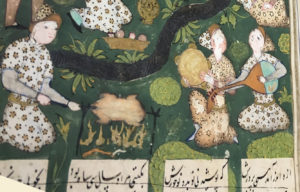—By Nicole Kang Ferraiolo
Editor’s note: This is the first post in a five-part series on the evolution of CLIR’s Digitizing Hidden Special Collections and Archives Program.
The year was 2014 and CLIR had big news: it would be winding down its longstanding cataloging grant program and replacing it with a new program supporting the digitization of rare and unique cultural heritage material, funded by The Andrew W. Mellon Foundation. Sometime between holding the advisory meetings, gathering community feedback, and running the final cycle of the previous program, CLIR hired an earnest new program officer, brimming with enthusiasm and self doubt. You could say that the Digitizing Hidden Collections program and I grew up together over these past five years. Before coming to CLIR, I had worked in the digital cultural heritage sector and overseen fellowship programs, but this was my first time working in an institutional grantmaking context. Specifically, it was my first time as a program officer.
What made the program officer role different from any of my previous jobs was the centrality of listening. Listening to people’s ideas for projects was perhaps the most visible function of the position. In the case of the Hidden Collections programs, this meant getting paid to learn about some of the most incredible collections in North America and think about how to preserve them and make them discoverable. On our occasional site visits, I’d get to listen to the wisdom of grant recipients and glimpse the collections’ treasures. It was my personal version of heaven.
As a member of CLIR’s grants team, it was my responsibility to listen for something else too: how to make a better funding program. How do you effect good governance in the context of grantmaking? You want your program to be equitable, accessible, ethical, and transparent. You want to do as much as possible with the limited funds available, without falling into the traps of utilitarianism. You want to incentivize better behavior without falling into the traps of paternalism. You want to do good, but you also want to do no harm. You end up asking yourself existential questions like: What is good? What is fair? And who are we to answer these questions?
That’s where the listening comes in. A program that serves a community must be informed by that community. Period. There is a very real risk that the rules governing who receives funding and who is left behind reflect the priorities (and inevitably, the biases) of a small group of individuals. For that reason, funding decisions for the Hidden Collections program, and all of CLIR’s regranting programs, are made by independent review panels representing diverse perspectives. CLIR’s review panelists also serve in an advisory capacity and the programs’ policy decisions are directly informed by reviewers’ unique professional expertise and lived experiences.
Our duty to listen is part of why CLIR’s program officers dedicate so much time to meetings and conference outreach. In addition to sharing information about our programs, we are there for the other participants’ presentations, for those spontaneous conversations in the hallways, and to scout out new voices that could enrich our review/advisory committees. The reviewers we invite to serve often have robust community engagement roles, which extends the number of ears CLIR has in the field and connects our programs to the conversations happening in forums where we do not (yet) have a presence.
While we seek to do as much as we can with our limited time and funds, we recognize that there are always better and more ways to listen. Luckily, our outreach activities are supplemented by direct feedback from applicants, which we receive frequently thanks to the openness and generosity of our community. While we can’t follow all of the suggestions we receive, we always take input seriously and refer to it when making decisions about the future of the program. This holds true for recommendations about how we listen and who we’re listening to.
This year, Digitizing Hidden Collections turns five and with it marks my fifth year at CLIR. In light of these two milestones, I wanted to reflect on some of the feedback we’ve been privy to in this time, the conversations it’s inspired, and the very real changes that have resulted from it. As such, this is the first post in a series called “Five Years of Listening,” which will be published over the next few weeks. To anyone who has shared ideas with CLIR staff—or our counterparts at other funding organizations—to try to make a better grant program, consider this series my small way of saying, thank you.
While we’re talking about it, if you have feedback or ideas to share about Digitizing Hidden Collections and/or Recordings at Risk, or general thoughts for CLIR’s grantmaking team, you can submit them here or write to hiddencollections@clir.org or recordingsatrisk@clir.org.
The Digitizing Hidden Special Collections and Archives program is made possible by funding from The Andrew W. Mellon Foundation.
Image detail; photo courtesy of Free Library of Philadelphia, Manuscripts of the Muslim World. John Frederick Lewis Collection of Oriental Manuscripts, Lewis 0 51.
Read other posts in the series:
- Five Years of Listening, Jan. 31, 2019
- Digitization and the Dream of Openness, Feb. 7, 2019
- More Equitable Partnerships in Grant Funding, Feb. 21, 2019
- Toward a More Inclusive Grant Program, Mar. 12, 2019
- Still Listening, April 11, 2019


